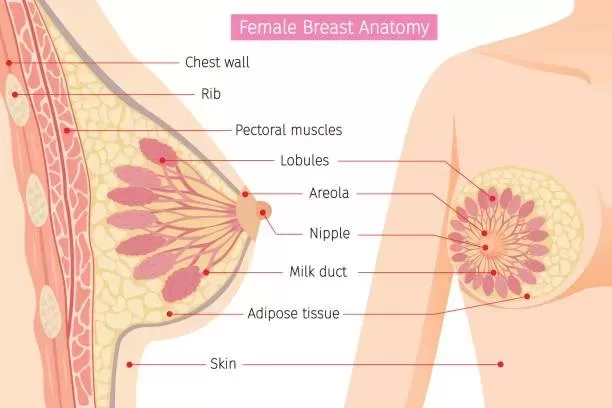I. Breast Anatomy, Health, and Myths
Breast is an important part of a woman’s body which has the main function as a reproductive organ for breastfeeding. Apart from that, it also plays a role in psychological and sexual aspects. Therefore, understanding about health breast very important for every woman.
II. Breast Anatomy
Breasts consist of several main components, namely adipose tissue (fat), mammary glands, milk ducts and pectoralis muscles. Fat tissue gives shape to the breasts while the mammary glands are responsible for producing breast milk when a woman breastfeeds. Milk ducts function as channels that connect the mammary glands to the nipples. Changes in the breasts occur throughout a woman’s life cycle, from puberty to menopause. The hormones estrogen and progesterone play an important role in these changes.
III. Breast Health
Routine monitoring of the condition of the breast is very important to detect early changes or abnormalities such as lumps or changes in skin texture in the breast area. This can be done through a self-examination (Self-Breast Examination) at home or medical screening such as a mammogram or breast ultrasound.
IV. Disease
Several diseases can affect the condition of the breasts, including:
1) Breast cancer : This is the most common type of cancer among women. Risk factors include family history, age, lifestyle, etc. Treatment may involve surgery, chemotherapy, radiotherapy, hormone therapy or a combination of these.
2) Mastitis: Infections in breast tissue are usually caused by Staphylococcus aureus bacteria. Symptoms include swelling, pain and heat in certain areas.
3) Fibroadenomas and Cysts: Fibroadenomas are benign tumors that generally do not cause pain while cysts are fluid-filled sacs in breast tissue.
V. Distinguishing Myths and Facts
There are many myths surrounding breasts – for example that large sizes increase the risk of cancer – but research does not support these claims. The real fact is that breast cancer risk is more related to genetic and environmental factors than to size itself.
VI. Plastic Surgery
Some women choose to undergo plastic surgery on breastsuch as augmentation (volume addition), reduction (volume reduction) or reconstruction (reshaping after mastectomy). These procedures have their own benefits and risks, and should be considered carefully.
VII. Breast-feed
Breastfeeding not only provides important nutrition for the baby, but also has health benefits for the mother, including a reduced risk of breast and ovarian cancer. Problems that may occur during breastfeeding include infections nipple (mastitis) and engorgement.
VIII. Conclusion
An understanding of the anatomy, function and care of breasts is very important for every woman. Having regular check-ups can help detect problems early, so treatment can begin as soon as possible. Every woman should feel comfortable in her own body and know the facts versus myths about breasts. This way, they can make informed decisions about their health.
News
Berita
News Flash
Blog
Technology
Sports
Sport
Football
Tips
Finance
Berita Terkini
Berita Terbaru
Berita Kekinian
News
Berita Terkini
Olahraga
Pasang Internet Myrepublic
Jasa Import China
Jasa Import Door to Door
